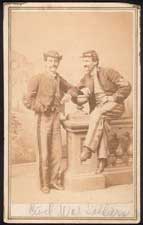The Civil War
is often called the first modern war. For the first time,
mass armies confronted each other wielding weapons created
by the industrial revolution. The resulting casualties dwarfed
anything in the American experience. More than 600,000 men
died, the equivalent in today's population of 5 million.
In population and economic
resources, the North far exceeded the South. Yet the Union's
task also eclipsed that of the Confederacy. To win, the North
had to conquer an area as large as Western Europe, subduing
armies defending their own soil. Only after a string of defeats
did Lincoln find generals able to bring the North's advantages
to bear on the battlefield.
Within days of the firing on
Fort Sumter, tens of thousands of volunteers heeded the call
of the opposing sides. Later, as enthusiasm for enlistment
waned, both sides resorted to the draft, with men able to
escape military service if they paid a prescribed amount of
money or furnished a substitute.
 Each
army was a cross section of its society. The Northern forces
were mostly farm boys, artisans, and urban workers, supplemented
after 1862 by 180,000 black soldiers and about 20,000 black
sailors; the Southern army was made up of small farmers, with
slaveholders dominating the officer corps. Few of these recruits
had military experience or were ready for the monotony of
life in camp - a constant round of digging ditches and incessant
drilling only occasionally interrupted by fierce bursts of
battlefield fighting.
Each
army was a cross section of its society. The Northern forces
were mostly farm boys, artisans, and urban workers, supplemented
after 1862 by 180,000 black soldiers and about 20,000 black
sailors; the Southern army was made up of small farmers, with
slaveholders dominating the officer corps. Few of these recruits
had military experience or were ready for the monotony of
life in camp - a constant round of digging ditches and incessant
drilling only occasionally interrupted by fierce bursts of
battlefield fighting.
Neither side was prepared for
modern war. Medical care was primitive; far more men died
of disease and inadequate treatment of wounds than in battle.
Some 50,000 Americans perished in military prisons, victims
of overcrowding and inadequate diet. Whatever later generations
came to believe, there was no romance in the Civil War.
The First Modern
War 



